Exploits of a Distance Pony - Story and Blog
Wednesday, January 30, 2008
The aches are barely starting and I’m already sitting down to write the latest ride story, which just goes to show how good the ride is…the worse the ride, the longer the story takes to get written, if it even does at all. And I’ve found that in my excitement over the ride, I ended up being rather verbose…so this story kind of goes on forever. All the excitement over a first 50, you know. It’s probably going to be a play-by-play of almost every mile of the trail, so will probably be a little bit boring in parts.
As a bit of a preface/introduction, I’ve been working on getting to a 50 mile endurance ride on a regular basis for the last year…my first 50 was supposed to be Land of the Sun 2007…the night before the ride, one of Mimi’s pasture-mates bit her in the middle of the back, right where the saddle sits. The entire year went that way…
an entire comedy of errors that culminated in me managing to get to 3 NATRC rides
and one LD ride. Not exactly what I would call a stellar year.
The 2008 ride season kicked off with an dubious start…
More...
Wednesday, January 30, 2008
Tuesday, January 22, 2008
What I Have Learned From Endurance Rides
Midsouthhorsereview.com - Full Story
"It helps to use food, treats, and verbal praise during the rides"
by Monica Rawson
Endurance riding is not for the weak at heart. Endurance riding has challenged me more than any other equine sport, from show jumping, dressage, foxhunts to cross country. Endurance riding has made me a stronger rider and taught me the importance of planning ahead, the value of consistency and how to set long range goals and have the patience to accomplish them one step at a time. I turned sixteen years old this past October and therefore "aged out" of the junior division. Zoie Starlite, my 17 year old Anglo- Arab mare and I have trained for endurance rides for over a year. We live outside Memphis, Tennessee and have been to many rides in most of the surrounding states competing in 25 mile, 50 mile and multi day rides.
Zoie has taught me that to be successful on endurance rides we both need to be mentally and physically ready. I discovered how much preparation is required to build up one's strength to persevere during the longer and more difficult and challenging rides. I learned not to think one race at a time, or even one season at a time. I think about how many races Zoie and I will be able to do over the next 20 years! While most other equine sports place winning, looks, or bloodlines as the number one priority, endurance riding puts the long-term health of the horse and rider as the first priority. Since I want to be an equine vet I agree with this mind-set and hate to see the long-term health of a horse or rider sacrificed for a short-term win. Slow and steady is better than going too fast too soon and suffering a physical or psychological set-back for the horse and/or rider.
To prepare for an endurance ride, my horse and I started slowly to build up our strength, even though we were not particularly weak. I began to ride Zoie for short distances at a slow speed until her muscles grew big and powerful. Her recovery time decreased after every ride and her heart rate would come down quickly as well. Zoie also had to learn how to drink out of mud puddles. I had to remember to carry a full water bottle with me so we would stay hydrated while we were on the trail. Zoie and I would warm up before every ride at the walk and the trot in order to prevent pulling muscles. This taught me about the importance of good conditioning which is necessary for a successful ride. I also learned the importance of preparing for different and ever changing terrains and weather. The safety of the horse and rider depends on proper preparation so you don’t freeze, over heat or get into a bad situation that could result in a pulled muscle, lameness, dehydration, or colic.
Endurance riding also taught me to be aware of the emotional needs of the horse before going out on an endurance ride. An emotionally unstable horse that has not built a trusting relationship with its rider could be very dangerous on an endurance ride. A horse will thrive when they have a consistent training program with the same handlers to keep their mind focused on the rider and the task at hand. When the horse has trust in the rider, he or she will cross streams, bridges, logs, and ditches without a problem. I have also found it helps to use food, treats, and verbal praise during the rides to keep my horse motivated.
Endurance riding also taught me to take care of myself. Before a ride I make sure that I get plenty of sleep, eat nutritious food and mentally plan ahead for the ride. This helps to build my patience and endurance under the stress of a long distance ride. Endurance riding has strengthened the relationship and trust between Zoie and I and we are both physically stronger and mentally confident. . I was aided in this learning experience by my endurance mentor. Jennifer Whittaker, of Mystic Rose Arabians, was my teacher and sponsor for most of my endurance rides, riding her stallion, Summer Saga. This coming year I will likely be riding endurance on a borrowed horse. Zoie is now in foal to Saga for 2008 n we have embarked on yet another new adventure!
More...
"It helps to use food, treats, and verbal praise during the rides"
by Monica Rawson
Endurance riding is not for the weak at heart. Endurance riding has challenged me more than any other equine sport, from show jumping, dressage, foxhunts to cross country. Endurance riding has made me a stronger rider and taught me the importance of planning ahead, the value of consistency and how to set long range goals and have the patience to accomplish them one step at a time. I turned sixteen years old this past October and therefore "aged out" of the junior division. Zoie Starlite, my 17 year old Anglo- Arab mare and I have trained for endurance rides for over a year. We live outside Memphis, Tennessee and have been to many rides in most of the surrounding states competing in 25 mile, 50 mile and multi day rides.
Zoie has taught me that to be successful on endurance rides we both need to be mentally and physically ready. I discovered how much preparation is required to build up one's strength to persevere during the longer and more difficult and challenging rides. I learned not to think one race at a time, or even one season at a time. I think about how many races Zoie and I will be able to do over the next 20 years! While most other equine sports place winning, looks, or bloodlines as the number one priority, endurance riding puts the long-term health of the horse and rider as the first priority. Since I want to be an equine vet I agree with this mind-set and hate to see the long-term health of a horse or rider sacrificed for a short-term win. Slow and steady is better than going too fast too soon and suffering a physical or psychological set-back for the horse and/or rider.
To prepare for an endurance ride, my horse and I started slowly to build up our strength, even though we were not particularly weak. I began to ride Zoie for short distances at a slow speed until her muscles grew big and powerful. Her recovery time decreased after every ride and her heart rate would come down quickly as well. Zoie also had to learn how to drink out of mud puddles. I had to remember to carry a full water bottle with me so we would stay hydrated while we were on the trail. Zoie and I would warm up before every ride at the walk and the trot in order to prevent pulling muscles. This taught me about the importance of good conditioning which is necessary for a successful ride. I also learned the importance of preparing for different and ever changing terrains and weather. The safety of the horse and rider depends on proper preparation so you don’t freeze, over heat or get into a bad situation that could result in a pulled muscle, lameness, dehydration, or colic.
Endurance riding also taught me to be aware of the emotional needs of the horse before going out on an endurance ride. An emotionally unstable horse that has not built a trusting relationship with its rider could be very dangerous on an endurance ride. A horse will thrive when they have a consistent training program with the same handlers to keep their mind focused on the rider and the task at hand. When the horse has trust in the rider, he or she will cross streams, bridges, logs, and ditches without a problem. I have also found it helps to use food, treats, and verbal praise during the rides to keep my horse motivated.
Endurance riding also taught me to take care of myself. Before a ride I make sure that I get plenty of sleep, eat nutritious food and mentally plan ahead for the ride. This helps to build my patience and endurance under the stress of a long distance ride. Endurance riding has strengthened the relationship and trust between Zoie and I and we are both physically stronger and mentally confident. . I was aided in this learning experience by my endurance mentor. Jennifer Whittaker, of Mystic Rose Arabians, was my teacher and sponsor for most of my endurance rides, riding her stallion, Summer Saga. This coming year I will likely be riding endurance on a borrowed horse. Zoie is now in foal to Saga for 2008 n we have embarked on yet another new adventure!
More...
Tuesday, January 15, 2008
What the crew thinks of the richest ever endurance ride.
The Sheik Mohammed bin Rashid Al Maktoum Endurance Cup is being hailed as the greatest endurance ride in the history of the sport after the world record breaking victory by UAE rider Omair Hussain Al Beloushi on a 10 year old Arab gelding Charlandre El Sharif.
That all fine, but what is it like to CREW in the most prestigious ride ever?
I've been crewing at international rides for over 12 years - from European Championships to "ordinary" FEI 3 stars; but always in Europe. This was my first trip to the UAE.
From the moment I arrived here I realised that this is an incredible place. I landed at 1.00am local time. The airport was packed with people, the roads were crammed with traffic and the building sites - the seemingly endless building sites - were all working flat out.
That was back on the 3rd Jan because I came over at the same time as our horse. (As trainer, crew, groom and person-responsible-for-all-things-that-go-wrong, it fell to me to be here to meet our horse and manage her through to ride day.)
Next morning I was up early to greet Khadidja du Pont (our 10 year old Arab mare) as she arrived at the quarantine stables after her 19 hours trip from our home in England's Cotswolds.
I continue to be amazed. The stables are of course air conditioned, the vets are on hand to take bloods and do free post-travel analysis for us if we wish (which of course we do) and there is an impressive system in place - backed up by lots of people - to not only enforce the quarantine regime but also to meet all our requests for feed, hay, bedding, buckets, and information.
In all we have 27 European horses stabled in 3 barns inside our quarantine compound with a clearly marked 19km quarantine exercise circuit for us to walk and ride our horses.
And all of this just minutes away from the jaw-droppingly awesome venue - Dubai Endurance City.
I took a trip to DEC a few days before the ride - an army of gardeners were watering the grass and clipping the hedges. The place is amazing.
The other thing that hits you is the profile of endurance out here. I blagged my way into the launch press conference in a downtown Dubai hotel - another well organised highly professional event -with lots of media present. Gulf news the leading English language paper in the region is full of our sport, you'll be familiar with that from seeing their articles on endurance.net. But that's just the tip of the iceberg - the local Arabic language media are just as interested in endurance.
Most days I saw journalist and TV crews around the exercise circuit looking for European riders they recognised to interview. I tried hard to look like an important rider. I guess there is something about me that says "He's only the crew". If we are lucky enough to get an invite again I'll have a T shirt with "I'm also an Advance Level rider" written on it (perhaps in French).
And then, after a few days rest for the horse and a few days riding, my wife arrives and we prepare for the off.
Just when I thought I'd got used to Dubai, race day is upon us.
As if the spectacle of 107 starters ("The largest field ever seen outside of a major championship") isn't enough, you have to come to terms with the fact that the big UAE stables travel in numbers. It seems as if each UAE horse has a whole legion of crew at the vet gate. (Note: what is the collective noun for crew?)
And then there is the vet gate itself. Dubai Endurance City looks even more incredible bathed in powerful floodlights. Big screen coverage on site; 7 different restaurants all alive at 6.00am (heaven help the crew who sneaks off for breakfast right now); you can't help but get nervous.
The race itself was astonishing. You can read elsewhere about Omair Husain Al Bloushi,
We watched - his horse was as bright as a button at the end. But let me tell you about crewing this ride.
In some ways crewing here seems easy - nearly all of the ride is accessible to 4x4 vehicles. You can literally drive alongside the course - hence the movie footage you can see. And this is made easier still by the marking - lots of flags, regularly placed and although many of the stages have common elements there are teams out all day taking away coloured flags from loops now completed to minimize scope for confusion.
But in other ways crewing is difficult. Firstly, there is a great deal of deep, deep sand to navigate - far more than the riders and horses have to contends with because (rightly) they get the best surface and the crews take whatever is alongside. Skillful experienced desert drivers can cope with this without getting stuck, those with less desert experienced or who are just bad drivers can only get through it if they drive at speed. You will be amazed how many Arabs join folk like me in the second category. Secondly there is a huge amount of traffic - especially on the first loop - and no rules of the road (because there is no road?) The organisers provided free 4x4 convoys for spectators; the nearby Bab Al Shams Desert Hotel did the same for their guests - and this was designed to REDUCE the number of vehicles following the riders!!
As you can imagine at the start traffic congestion is at its worst.
When we set off into the jet black of the pre-dawn desert at the beginning of the first 32km stage it was like being in the whacky races. All around us hundreds (literally hundreds) of 4x4 vehicles of every shape and make - including ambulances, police and TV crews. They all flashed through the desert, each one carving out its own route and seemingly oblivious to everyone else.
Every vehicle had two objectives: to follow the ride (and in the case of the crews their horse), and not to get stuck in the deep sand.
As we dodged our way through the cars that had already got stuck it became increasingly difficult to maintain momentum without crashing into someone. Eventually our luck ran out, as I swerved to avoid the suddenly stationary car in front the nose of our car dropped down into a deep trough and we were stuck. Buried up to our front axles we had no hope of freeing our crew vehicle. It was less than 20 minutes into the race, we hadn't seen our rider and we couldn't move.
All around us others were in the same predicament. We saw 2 police vehicle and an ambulance nearby - helpless in the sand.
We watched in desperation as the Dubai Equestrian Club's own tow truck slowly worked its way up the hill pulling out one car after another. By the time they pulled us out it was light and we were worried that we wouldn't get back to the vet gate before the horse. We drove back to DEC arriving just in time to get organised before Janice and Khadidja came in to VG1.
From that point on we left a crew member behind at the venue to ensure we would have some Vet Gate support if the worst happened.
Daylight, the spreading out of the field and the VG1 eliminations greatly reduced the congestion on the track. From that point on, although we had some scary moment, we didn't get stuck again. Many other crews did and it remained a real concerned right through to the end of the last loop.
The business of crewing from the start of the second loop was almost ordinary. We had picked up some bottled mineral water (provided free at the start) to use on the run and we made full use of the water stations - located 2 or 3 times each loop and offering a row of big drinking troughs constantly replenished by the organizers. These troughs gave us an opportunity to refill some bottles and to scoop water over the horse.
We were blessed with cool temperatures all day, so dehydration never became an issue for us.
Again thanks to conditions very similar to our summer back home the vet gate procedures ran smoothly for us. Khadidja du Pont presented to the vet in under 4 minutes (average across the day) and we were being conservative. She breezed through the vettings and the 3 compulsory re-exams. During the holds (30 and 40 minutes) we usually needed to put a rug on her to keep her warm. We used Equi-N-Ice coolant to chill leg bandages too - a big help as much of the course was very concussive.
There was just one other issue for us - fuel consumption. The high revving and hard driving to get through the deep sand pushed fuel consumption through the roof and my hired 4x4 ( a small Mitsubishi Outlander) simply didn't have a big enough tank. Before half way I realized that I was going to use MORE than a tank of petrol (another weakness: because the stuff is so cheap out here most vehicles are petrol doing less miles per gallon that the diesels we have back home).
At one Vet Gate as soon as the horse passed the vet I had to leave my wife and two fellow crew to manage the hold time and re-exam so that I could get fuel. Because DEC is in the middle of nowhere that was a 60km round trip. By the time I got back Janice and Khadidja where out on the 5th stage. I caught up with her as soon as I could, but it did cost us a little as the horse was not as wet as I would have liked leaving the vet gate and I'd missed some early opportunities to crew on the course. At this stage I think it would have been really helpful for psychological reasons as the two were all alone. There pace slipped a little on this circuit and I blame myself for that.

Iain and Khadidja du Pont
Janice was the first British rider to cross the line finishing in 23rd place, the 4th European combination to finish. Not bad for our first trip to the desert.
And after all that it really did feel as if we'd taken part in the most prestigious ride in the history of endurance. Top marks to the Dubai Equestrian Club. What an experience...
Iain Cockely-Adams
That all fine, but what is it like to CREW in the most prestigious ride ever?
I've been crewing at international rides for over 12 years - from European Championships to "ordinary" FEI 3 stars; but always in Europe. This was my first trip to the UAE.
From the moment I arrived here I realised that this is an incredible place. I landed at 1.00am local time. The airport was packed with people, the roads were crammed with traffic and the building sites - the seemingly endless building sites - were all working flat out.
That was back on the 3rd Jan because I came over at the same time as our horse. (As trainer, crew, groom and person-responsible-for-all-things-that-go-wrong, it fell to me to be here to meet our horse and manage her through to ride day.)
Next morning I was up early to greet Khadidja du Pont (our 10 year old Arab mare) as she arrived at the quarantine stables after her 19 hours trip from our home in England's Cotswolds.
I continue to be amazed. The stables are of course air conditioned, the vets are on hand to take bloods and do free post-travel analysis for us if we wish (which of course we do) and there is an impressive system in place - backed up by lots of people - to not only enforce the quarantine regime but also to meet all our requests for feed, hay, bedding, buckets, and information.
In all we have 27 European horses stabled in 3 barns inside our quarantine compound with a clearly marked 19km quarantine exercise circuit for us to walk and ride our horses.
And all of this just minutes away from the jaw-droppingly awesome venue - Dubai Endurance City.
I took a trip to DEC a few days before the ride - an army of gardeners were watering the grass and clipping the hedges. The place is amazing.
The other thing that hits you is the profile of endurance out here. I blagged my way into the launch press conference in a downtown Dubai hotel - another well organised highly professional event -with lots of media present. Gulf news the leading English language paper in the region is full of our sport, you'll be familiar with that from seeing their articles on endurance.net. But that's just the tip of the iceberg - the local Arabic language media are just as interested in endurance.
Most days I saw journalist and TV crews around the exercise circuit looking for European riders they recognised to interview. I tried hard to look like an important rider. I guess there is something about me that says "He's only the crew". If we are lucky enough to get an invite again I'll have a T shirt with "I'm also an Advance Level rider" written on it (perhaps in French).
And then, after a few days rest for the horse and a few days riding, my wife arrives and we prepare for the off.
Just when I thought I'd got used to Dubai, race day is upon us.
As if the spectacle of 107 starters ("The largest field ever seen outside of a major championship") isn't enough, you have to come to terms with the fact that the big UAE stables travel in numbers. It seems as if each UAE horse has a whole legion of crew at the vet gate. (Note: what is the collective noun for crew?)
And then there is the vet gate itself. Dubai Endurance City looks even more incredible bathed in powerful floodlights. Big screen coverage on site; 7 different restaurants all alive at 6.00am (heaven help the crew who sneaks off for breakfast right now); you can't help but get nervous.
Wacky Races
The race itself was astonishing. You can read elsewhere about Omair Husain Al Bloushi,
We watched - his horse was as bright as a button at the end. But let me tell you about crewing this ride.
In some ways crewing here seems easy - nearly all of the ride is accessible to 4x4 vehicles. You can literally drive alongside the course - hence the movie footage you can see. And this is made easier still by the marking - lots of flags, regularly placed and although many of the stages have common elements there are teams out all day taking away coloured flags from loops now completed to minimize scope for confusion.
But in other ways crewing is difficult. Firstly, there is a great deal of deep, deep sand to navigate - far more than the riders and horses have to contends with because (rightly) they get the best surface and the crews take whatever is alongside. Skillful experienced desert drivers can cope with this without getting stuck, those with less desert experienced or who are just bad drivers can only get through it if they drive at speed. You will be amazed how many Arabs join folk like me in the second category. Secondly there is a huge amount of traffic - especially on the first loop - and no rules of the road (because there is no road?) The organisers provided free 4x4 convoys for spectators; the nearby Bab Al Shams Desert Hotel did the same for their guests - and this was designed to REDUCE the number of vehicles following the riders!!
As you can imagine at the start traffic congestion is at its worst.
When we set off into the jet black of the pre-dawn desert at the beginning of the first 32km stage it was like being in the whacky races. All around us hundreds (literally hundreds) of 4x4 vehicles of every shape and make - including ambulances, police and TV crews. They all flashed through the desert, each one carving out its own route and seemingly oblivious to everyone else.
Every vehicle had two objectives: to follow the ride (and in the case of the crews their horse), and not to get stuck in the deep sand.
As we dodged our way through the cars that had already got stuck it became increasingly difficult to maintain momentum without crashing into someone. Eventually our luck ran out, as I swerved to avoid the suddenly stationary car in front the nose of our car dropped down into a deep trough and we were stuck. Buried up to our front axles we had no hope of freeing our crew vehicle. It was less than 20 minutes into the race, we hadn't seen our rider and we couldn't move.
All around us others were in the same predicament. We saw 2 police vehicle and an ambulance nearby - helpless in the sand.
We watched in desperation as the Dubai Equestrian Club's own tow truck slowly worked its way up the hill pulling out one car after another. By the time they pulled us out it was light and we were worried that we wouldn't get back to the vet gate before the horse. We drove back to DEC arriving just in time to get organised before Janice and Khadidja came in to VG1.
From that point on we left a crew member behind at the venue to ensure we would have some Vet Gate support if the worst happened.
Daylight, the spreading out of the field and the VG1 eliminations greatly reduced the congestion on the track. From that point on, although we had some scary moment, we didn't get stuck again. Many other crews did and it remained a real concerned right through to the end of the last loop.
The business of crewing from the start of the second loop was almost ordinary. We had picked up some bottled mineral water (provided free at the start) to use on the run and we made full use of the water stations - located 2 or 3 times each loop and offering a row of big drinking troughs constantly replenished by the organizers. These troughs gave us an opportunity to refill some bottles and to scoop water over the horse.
We were blessed with cool temperatures all day, so dehydration never became an issue for us.
Again thanks to conditions very similar to our summer back home the vet gate procedures ran smoothly for us. Khadidja du Pont presented to the vet in under 4 minutes (average across the day) and we were being conservative. She breezed through the vettings and the 3 compulsory re-exams. During the holds (30 and 40 minutes) we usually needed to put a rug on her to keep her warm. We used Equi-N-Ice coolant to chill leg bandages too - a big help as much of the course was very concussive.
There was just one other issue for us - fuel consumption. The high revving and hard driving to get through the deep sand pushed fuel consumption through the roof and my hired 4x4 ( a small Mitsubishi Outlander) simply didn't have a big enough tank. Before half way I realized that I was going to use MORE than a tank of petrol (another weakness: because the stuff is so cheap out here most vehicles are petrol doing less miles per gallon that the diesels we have back home).
At one Vet Gate as soon as the horse passed the vet I had to leave my wife and two fellow crew to manage the hold time and re-exam so that I could get fuel. Because DEC is in the middle of nowhere that was a 60km round trip. By the time I got back Janice and Khadidja where out on the 5th stage. I caught up with her as soon as I could, but it did cost us a little as the horse was not as wet as I would have liked leaving the vet gate and I'd missed some early opportunities to crew on the course. At this stage I think it would have been really helpful for psychological reasons as the two were all alone. There pace slipped a little on this circuit and I blame myself for that.

Iain and Khadidja du Pont
Janice was the first British rider to cross the line finishing in 23rd place, the 4th European combination to finish. Not bad for our first trip to the desert.
And after all that it really did feel as if we'd taken part in the most prestigious ride in the history of endurance. Top marks to the Dubai Equestrian Club. What an experience...
Iain Cockely-Adams
Wednesday, January 02, 2008
New Year's In New Mexico 07: A Lesson in Contrasts
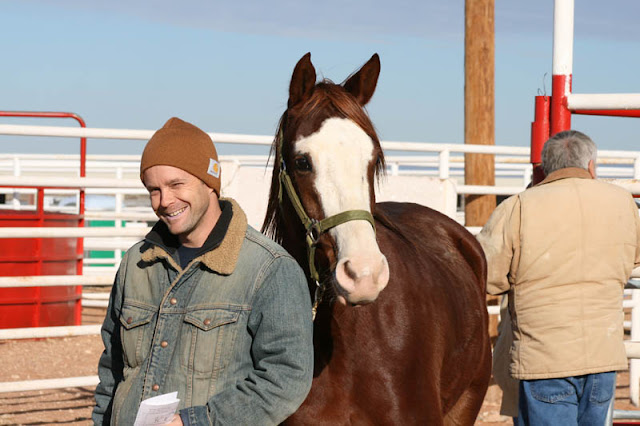  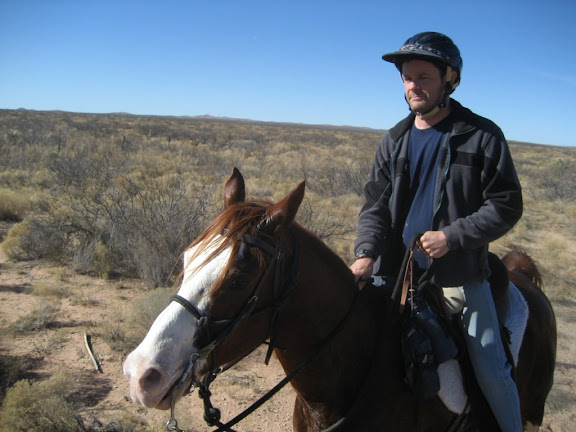 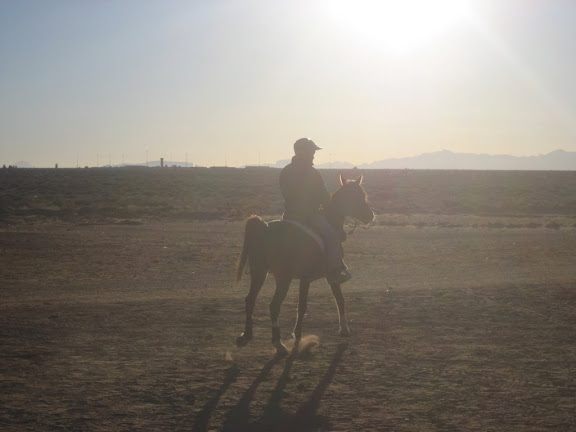 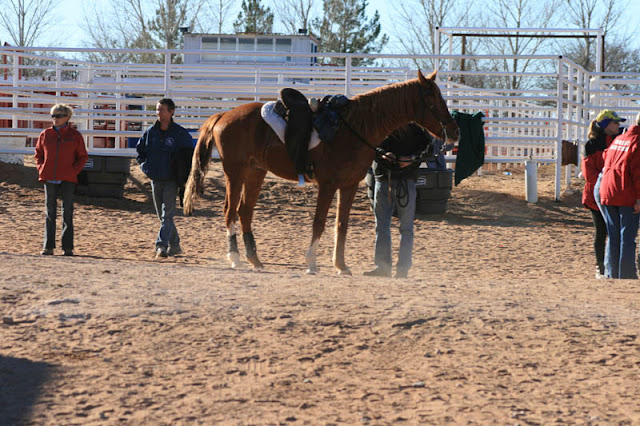 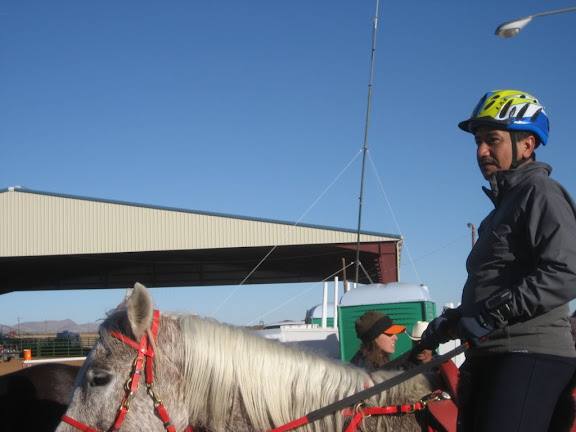 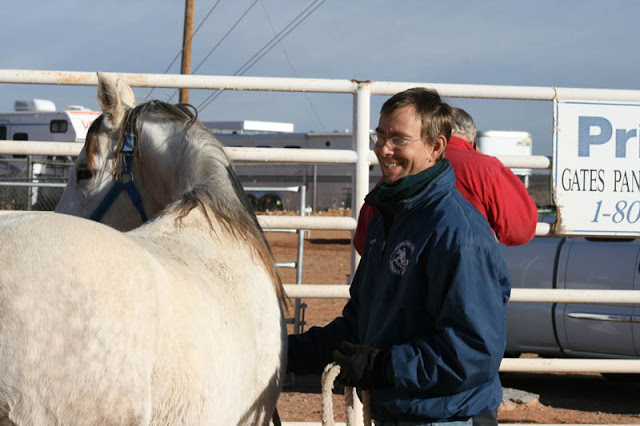 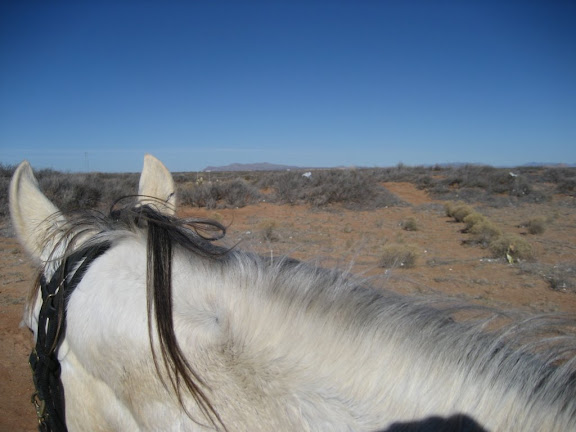 | January 2 2008 My own humble experience at the Las Cruces two-day ride amid the hustle and bustle of the FEI qualification attempts was one of strategically conservative riding on two horses the span the spectrum of character and gait. The more I am exposed to horses, the more I realize how drastically different each one is from the next. Knowing the trail on Day 1 would be shared with some fast-moving horses, I chose to ride Red because he would be less distracted by the activity around him. Red is six; I got him just over a year ago and this was his fourth 50-mile ride. The race started at 8 AM – there were only 12 starters in the 50. We left with the big group, and Red settled immediately into a warm-up trot and our pace stayed between 8.5 and 8.9 mph for the 15 mile loop. A couple of riders passed us near the beginning, and we would be passed by other riders on the common trail throughout the day, but we essentially rode the entire day alone. It was fascinating to be out there riding my own quiet ride and to be sharing the trail and getting passed by the Sheika Madiea from the UAE; the King of Malaysia and Valerie Kanavy. There was water every five miles and Red drank from every tank. The late December desert was devoid of much to eat, so Red was happy to get back to camp and his food. Rusty only rode on Day 2 because he was supposed to crew for some of the Malaysian Team, but they seemed to have as many crew as they needed, leaving Rusty to generously crew for me. It is such a treat to have someone waiting there for you at the vet check with a horse blanket, hay, and willingness to trot the horse out for you. The 45-minute hold passed quickly and we were out again to take on the 25-mile loop. We kept a consistent 7.5 - 8 mph trot for much of the loop, and took 3h40 to complete the section. It felt like a long loop to me, but it did bring us to the 40-mile mark. Red drank his way along in five-mile increments; did not falter when some of the 100-milers cantered past us; and kept an amazingly constant output of energy and willingness for the entire loop. His gait remained smooth and relaxed and he flexed nicely at the pole with gentle teasing of the bit. Red is a kind and gentle soul who is much more advanced than I on his path to enlightenment. Back at the check, Rusty worked his magic with me and the horse and had us back out on our ten mile loop on time without any fuss or confusion. The ten miles passed quickly and I was pleased to be finished the course by 4:30, making our ride time almost exactly seven hours. The sun was beginning to hang low and the temperature was beginning to drop. It probably stayed below 52 degrees at the heat of the day. The terrain was mostly flat with good to excellent footing. There was only 2,000 feet of elevation gain over the entire 50 miles. And although the loops took you up and around the local landfill, the trail was pretty and the miles did not feel that they came at the expense of the horse the way a tough trail can seem. Clydea served us delicious food on all three days – from home-made pot roast to the best thanksgiving turkey soup I will ever enjoy. I was in bed a little after 7 PM, leaving the drama and challenge of the remaining 100-milers to others. I would ride Far on Day 2 and I knew his approach to the work would take more skill and focus from me in order to be successful. This would be his second 50, and although he is seven, his mind works at a fast pace and he can be easily stirred up into a tempest if he is not treated with care. I was up at 6 AM, which left plenty of time for horses and humans to eat and get ready. Rusty was to join us today on Rocky, his little bullet of a horse, who is also excitable, powerful, and for whom this would also be a second ride. We waited for the group to leave, knowing that the first 15 miles or so would have to stay as controlled as possible in order for our ride to be successful. We started out with John Teeter, and within half a mile, caught up to Jim and Clydea Hastie. A small herd of cattle were between them and the trail ahead. I had forgotten that Far had spent some time on a cattle ranch (thanks to the great Leslie Spitzer), which would have explained why Far seemed relatively unfazed by the commotion. John rode off ahead and herded the cattle off the trail for the rest of us. Far and I found ourselves at the front of a group of five. He felt like he wanted to explode – his gait had more elevation than travel, mostly because I was holding him back at 7 mph, when he would much rather have been traveling at double digits. His gait was springy and soon John and the Hasties passed us, leaving Rusty and me to gently negotiate our pace. Far would remain juiced for 40 miles – his gait stayed energetic and challenging to ride. He is a horse who is happier when he can move out at a good pace – I am looking forward to getting him to the fitness level to be able to do that. The trail was littered with yucca trees, and he did not like them any more at the end of the ride than at the beginning. Our pace was interrupted from time to time with shies from one side to the other. I was pleased the first loop on this day was the 25-miler. Far’s recoveries were exceptional all day, although he scored a C on gut sounds at the 25-mile check. It gave me something to worry about for the 15-mile loop even though he spent the first check eating constantly. At 40 miles his gut sounds were a B and the last ten miles were nothing short of heavenly. I finally let Rusty and Rocky lead, which I should have done earlier in the day. Far’s head came down; he worked better off the bit and his gait smoothed out. We finished the day at sunset – eight hours of riding time and neither horse had dropped much in their energy levels or attitude. They are both exceptional movers with lots of hind end power and legs of steel. They ate and drank all day. Today, the day after we traveled home, Far is out in the paddock cantering with his Jolly Ball and having a fine time: the ride seems not to have taken anything from him. We enjoyed good Mexican food at the New Year’s Eve Awards banquet, and called it a Day at 9:30 in the middle of a ferocious windstorm. It was the perfect way for me to end 2007: riding two horses on the same trail who took on the task in wildy opposite ways: they are as different from each other as you are from me. My two days on the trail could not have been more different than the FEI competitors whose race was about something much more serious. Happy New Year to one and all and here’s to a life filled with challenges and contrasts! Enduring: Kevin's Blog |
Subscribe to:
Posts (Atom)